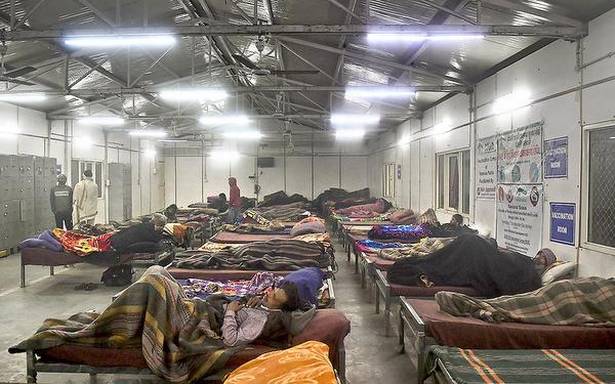People living in small shelter homes complain of inadequate space and poor sanitation facilities
For 63-year-old Harisingh Gujjar, a migrant from Rajasthan, taking refuge at a night shelter near the city’s Nigam Bodh Ghat has become a regular affair.
Ignoring the stained pillow and a dirty blanket that lay on his bed, Gujjar — who first arrived at the shelter about four years ago — said he had no family but was more than happy to have a place to sleep. “I get tea twice a day, and hot meals to feast on. I can’t earn anymore, so what else would I need during the winter?” he said with a wry smile.
With temperatures in Delhi dipping to single digit earlier this week — going as low as 3.6 degrees Celsius — the city’s homeless have taken to night shelters to survive the bone-chilling cold.
Gujjar is one among the many homeless men at the shelter, which has multiple porta cabins and tents that were established by the Delhi Urban Shelter Improvement Board (DUSIB) and has close to 500 beds and 30 toilets, according to the shelter’s caretaker.
While the homeless like Gujjar living in bigger shelters are seemingly content with the amenities available, such as food, beds, toilets and ample space, to help survive the harsh winter, homeless families living at the smaller tent-based shelters are far from happy with most stating that the setup in their shelters is quite the opposite.
Four years ago, Radha, a 27-year-old migrant from Madhya Pradesh, had first arrived at a container-based 40-bed shelter near the city’s Safdarjung Hospital after her husband’s kidney-related ailment took a turn for the worse.
“For three years, my husband was taking treatment at AIIMS which included dialysis. His treatment was interrupted during the first lockdown and we returned to our village where he expired soon after. I have come back here because my health is deteriorating and I am undergoing tests. But this shelter is packed, it has no facilities and all we have is a bed and a public washroom located slightly ahead,” said the mother of two, adding that she was dependent on those who donated food and blankets.
Adjacent to the shelter is a 16-bed tent set up by DUSIB where occupants said that the tents lacked provisions such as food and toilets. At a 16-bed tent-based shelter across the road, near AIIMS, space seemed to fall short with homeless individuals taking to the footpath alongside the shelter.
The occupants in all three shelters were patients awaiting treatment at the nearby hospitals. While most of them said they were content with the provisions, they emphasised the need for a dedicated toilet facility instead of a public washroom.
According to DUSIB’s occupancy report, while the original capacity of their shelters stood at 19,660, the revised capacity now stands at 9,026. DUSIB has shifted 2,594 homeless people to shelter homes since October 30.
Sanjay Kumar, co-director at Aashray Adhikar Abhiyan, an organisation that has been working towards the betterment of homeless people since 2000, said that 20% of Delhi’s homeless are vulnerable people, which include “women, senior citizens, mentally ill people, drug addicts, disabled individuals and children”.
Speaking of the shelter homes run by him, he added, “We are not just providing them shelter but also with vocational training and skill-building which has resulted in many of them getting jobs.”
Ram Satya Tiwari, who looks after a 450-bed shelter building at Fatehpuri, near the old Delhi railway station, said that overcrowding has become a growing concern there.
“Before the pandemic, we had mattresses on the floors but now we have beds and there aren’t enough of them. We try accommodating extra people by providing them with mattresses on the floor along with blankets but we still can’t accommodate everyone. We conveyed this to the authorities and they set up a few tents nearby but the space is insufficient. Another problem is that there are hardly any shelters for women in Old Delhi,” he said.
Responding to these observations, DUSIB member Bipin Rai said Delhi had “20 shelter facilities for women and 25 for families”. He added that most of these shelters are based in the walled city, while some were located in east Delhi and north Delhi.
“It depends on the demand; we provide the shelters for women according to the requirement and for a small number, we try accommodating them in nearby shelters. The container-like facility near Safdarjung was set up by a private agency and not DUSIB. However, if there are shortcomings in the DUSIB shelters then we will look into it. We have put a lot of effort into setting up shelters for the homeless. There are over 200 night shelters in the city, but many of the homeless people refuse to come,” said Mr. Rai.
Source: Read Full Article

